Tankers of His Majesty !!
The subject of this work is one of the pioneers of Armored Warfare with the English. It fought bravely in the fields of France and in the desert sands, but was quickly surpassed by more modern machines. Today we will learn about the history of the first operational of the Cruisers tanks: the Cruiser Mk.I tank A9.
 |
| Troubles in the desert!!! |
 |
| Cruiser Mk I (A9) British tank preserved at The Tank Museum Bovington - Dorset - England |
History
The Tank, Cruiser, Mk I (A9) was a British cruiser tank of the interwar period. It was the first cruiser tank: a fast tank designed to bypass the main enemy lines and engage the enemy's lines of communication, as well as enemy tanks.
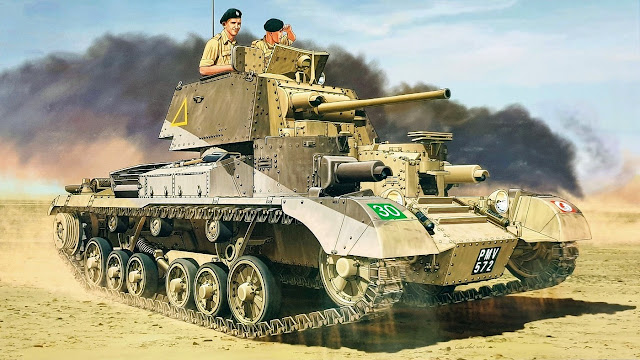 | |
|
The Cruiser Mk.II (A10) was a more heavily armoured adaptation of the Mark I, developed at much the same time.
 |
| Cruiser Tank A10 Mk.IA Gecko Models kit (#35GM0002) box art |
Design and development
In 1936, the British War Office designated two different kinds of tanks for future development: heavily armoured infantry tanks to be used in close co-operation with infantry during attacks, and fast mobile cruiser tanks designed to make forays deep into enemy territory.
Due to the cost, British replacement designs for Medium Mark II tanks then in service had been cancelled with only three Medium Mark III built. In 1934, Sir John Carden of Vickers-Armstrong was asked to provide a "reasonably cheap tank" as a replacement for some of the medium models then in use. This design was known by General Staff specification A9.
 |
| Vickers Medium Mark IIA tank font:IWM KID 113 |
 |
| Vickers Medium Mark III E1 font: IWM MH 8102 |
The pilot model of his medium tank design was finished in 1936 and given the designation A9E1. It incorporated the best features of the cancelled Medium Mk III design, but lighter so that it could be powered by a commercial petrol engine.
However, this was still in the time of the Great Depression and the tank had a number of cost-cutting measures applied. It was the first British tank to have a centrally located turret and to have powered traverse. The system was by Nash & Thompson and similar to that being introduced on the Vickers Wellington medium bomber aircraft.
%20Squadron%20RCAF%20board%20their%20Wellington%20Mk%20II%20at%20Pocklington,%20July%201941%20IWM%20(HU%20108387).jpg) |
| Aircrew of No. 405 (Vancouver) Squadron RCAF board their Wellington Mk II at Pocklington, July 1941. Notice the front turret power-operated by Nash & Thompson control unit font:IWM (HU 108387) |
The armour was light, with a maximum thickness of 14 mm (almost a standard for the time). Many armour faces were vertical, and there were numerous shot traps, but it could achieve 40 km/h and carried the new high velocity QF 2-pounder (40 mm) gun, which had replaced the QF 3-pounder (47mm) by the time manufacture started in 1937.
The driver's compartment and the fighting compartments were not separated. As well as the turret armament, which consisted of an Ordnance QF 2 pounder gun and a coaxial Vickers machine gun, there were two small turrets either side of the driver's compartment, each with an armoured Vickers machine-gun.
.jpg) |
| MG turret gunners and driver of a 1st Royal Tank Regiment A9 Cruiser Mk I tank (production version) at Abbasia, Egypt, 30 May 1940 font: IWM (E 100) |
Both of these smaller turrets were permanently manned, which gave the tank a total crew of six (commander, gunner, loader, driver and two machine-gunners).
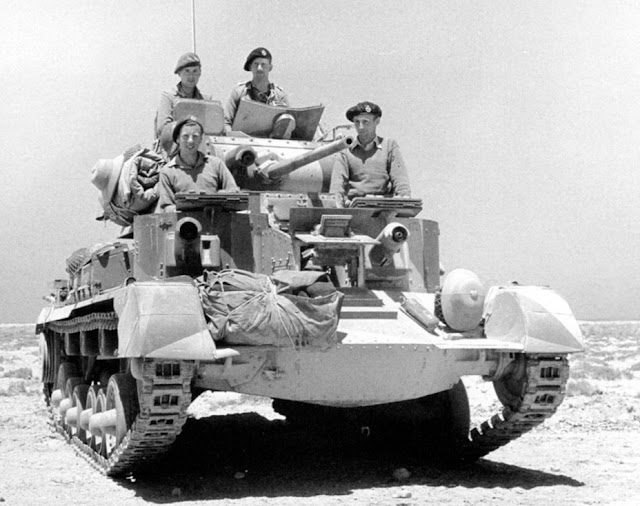 |
| Cruiser Tank Mk.I (A9) in North Africa with full crew. No sand shields are installed on the right side of the tank. |
The prototype A9E1 was tested against other designs and, although lacking in some areas, it was accepted in 1937 as an interim design until a Christie suspension cruiser tank could be delivered.
 |
| Cruiser Mk.I A9 suspension details |
 |
| The first experimental Cruiser tank A9E1 (BMM-133) Notice the absence of the guns, the primitive exhaust and the the cylindrical commander's cupola. left view - 1936 |
 |
| The first experimental Cruiser tank A9E1 (BMM-133) Notice the primitive exhaust with early rear deck and the cylindrical commander's cupola. rear view - 1936 |
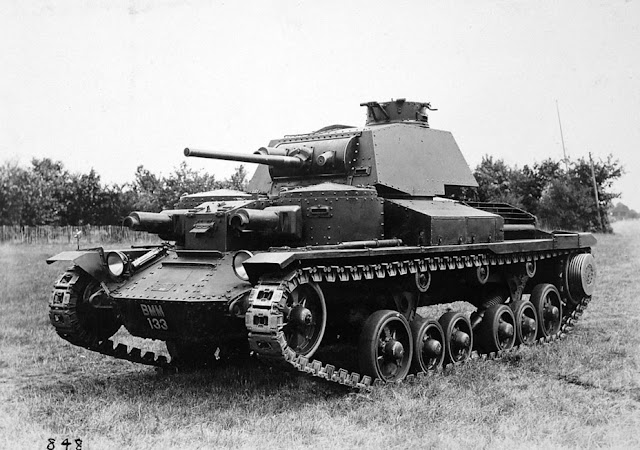 |
| The first experimental Cruiser tank A9E1 (BMM-133) fully assembled with new rear deck and the cylindrical commander's cupola front left view - 1936 |
 |
| The first experimental Cruiser tank A9E1 (BMM-133) fully assembled with new rear deck and the cylindrical commander's cupola front right view - 1936 |
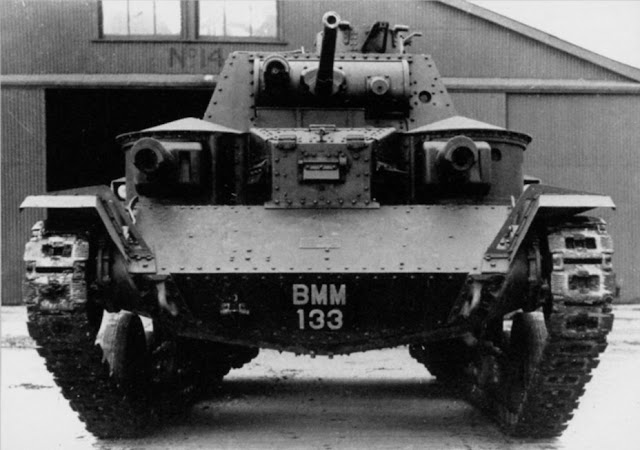 |
| The first experimental Cruiser tank A9E1 (BMM-133) fully assembled (but no MGs in the turrets with conical roofs) front view - 1936 |
 |
| Another prototype A9E1 tank, with cylindrical commander's cupola but with flat roof turrets, testing an underwater driving device |
An order was placed for 125. Seventy-five were built by Harland and Wolff, and the other 50 were built by Vickers. Initially, a Rolls-Royce car engine (the 7.67 litre of the Phantom II) was used for the pilot model, but this proved to be underpowered and was replaced by a 9.64 litre AEC bus engine.
 |
| AEC 6 cylinder engine installed on the rear deck of an A9 Cruiser undergoing field maintenance |
 |
| Production A9 Mk.I (CS) built by Harland & Wolff Ltd. Notice the flat roof auxiliary turrets right view |
 |
| Production A9 Mk.I. Notice the flat roof auxiliary turrets left view |
The later Valentine infantry tank essentially used the same lower hull and suspension, though with considerably more armour.
..bmp) |
| Infantry Tank Mk III Valentine II font: IWM (KID 652) |
The A9 weighed 12 long tons (12 t), was 5.8 m long, 2.65 m high, 2.5 m wide and had a top speed of 40 km/h on road and 24 km/h off. Its maximum road range was 240 km. The ammunition load was 100 rounds for the main gun and 3,000 rounds for the three machine guns.
Service
The Mark I cruiser began to be delivered in January 1939. 36 tanks were delivered before the start of the war, 40 in September–December 1939 and 49 in 1940.
 |
| Cruiser Mk I (A9) tanks on maneuvers, somewhere in England. Issues with tank production meant that the A9 was often seen operating alongside the (more modern) Cruiser Tank Mk.III and Matilda II tanks. |
%20%20IWM%20(KID%20359).jpg) |
| Brand new Cruiser Mk I (A9) tank font: IWM (KID 359) |
The Cruiser was an effective operational tank in the French, Greek and early North African campaigns. They fought intensely and bravely in these Theaters of Operations, but soon became obsolete in the face of better armed, armored and powerful German vehicles.
.jpg) |
| Cruiser Mk I (A9) tanks of 5th Royal Tank Regiment 3rd Armoured Brigade, 1st Armoured Division Thursley Common, Surrey, July 1940 font: IWM (H 2484) |
 |
| An abandoned Cruiser Mk.I A9 stranded on the side of a French country road Battle of France - 1940 |
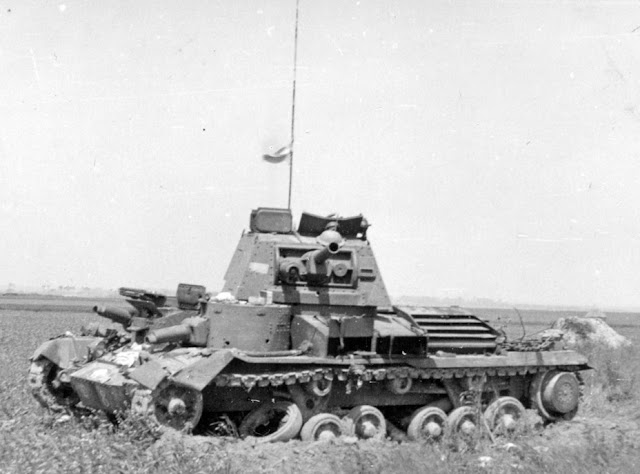 |
| A damaged Cruiser Mk.I A9 CS, seen here in France in 1940. Note the perforations on the side of the left front turret |
 |
| Cruiser Mk.I A9 CS abandoned somewhere in France being inspected by German soldiers - 1940 |
 |
| Cruiser Mk.I A9 CS abandoned somewhere in France being inspected by German soldiers - 1940 |
 |
| Cruiser Mk.I A9 abandoned in the Libyan Desert being examined by his Germanic captor - 1941 |
 |
| Typical British ingenuity: A Cruiser Mk.I A9 tank with its sunshield disguise open and closed, changing its appearance to lorry Desert Front - 1941 |
 |
| Abandoned Cruiser Mk I A9 CS tank of the 1st Armoured Division, Calais – 27 May 1940 This photo served as inspiration for the box art of the Bronco kit |
 |
| Another abandoned Cruiser Mk I A9 CS tank of the 1st Armoured Division, Calais – 27 May 1940 |
 |
| Abandoned Cruiser Mk I A9 tank being used as protection by a Wermach radio team - France, 1940. |
The 2-pounder gun was lethal against the early Italian tanks encountered during the North African campaign and could hold its own against Rommel's early Panzer IIs and Panzer IIIs.
It could also breach the 20 - 30 mm of protective steel on later opponents, such as the Panzer III Ausf F and the Panzer IV Ausf D.
It was effective until the Germans introduced the more thickly armoured Panzer IV Ausf E to the desert in the spring of 1941.
.jpg) |
| Cruiser Mk.I A9 tanks on the move near Tobruk - Libya 12 September 1941 font: IWM (E 5547) |
%20Arnold%20%20of%201st%20RTR%20(Royal%20Tank%20Regiment),%20Abbasia,%20Egypt,%2030%20May%201940%20-%20IWM%20(E%20101).jpg) |
| Cruiser Mk I (A9) tank ARNOLD at full speed 7th. Armoured Brigade - 1st RTR (Royal Tank Regiment) Abbasia, Egypt - 30 May 1940 font: IWM (E 101) |
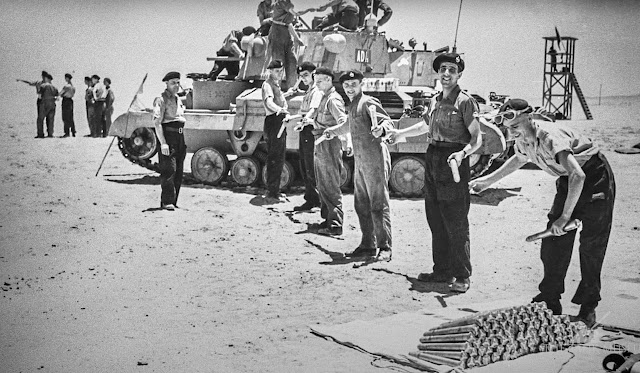 |
| Cruiser Mk I (A9) tank ADA being reloaded with 2 pdr AT shells. 7th. Armoured Brigade - 1st RTR (Royal Tank Regiment) pre-Operation Compass field exercises June - 1940 |
 |
| Cruiser Mk I (A9) tank ADA being reloaded with 2 pdr AT shells. 7th. Armoured Brigade - 1st RTR (Royal Tank Regiment) pre-Operation Compass field exercises closed view June - 1940 |
 |
| Cruiser Mk.I A9 tank crews of C Squadron 6th Royal Tank Regiment set up camp on the desert. Libyan frontier, 26 July 1940 font:IWM (E 387) |
.jpg) |
| A Cruiser Mk.I A9 tank being tranported by Scammell tank transporter named SNOW WHITE to the workshops for an overhaul. Western Desert, 18 July 1941 font: IWM (E 4232) |
 |
| Mack EXBX 18-ton 6×4 tank transporter loading a Cruiser Mk I CS - A9 North Africa - 1940 |
However, its minimal armour made the A9 very vulnerable to most Axis anti-tank weapons. Also problematic was the lack of high explosive shells for the 2-pounder gun, and even worse the lack of armour-piercing shells for the 94 mm gun on the CS (close support) version. Another issue was that the areas around the front machine gun turrets created a frontal surface that was more vulnerable to enemy fire than it would have been had it been a simple flat plate.
 |
| Cruiser Mk I (A9) tank 7th. Armoured Brigade - 1st RTR (Royal Tank Regiment) left view - Notice the sand shield Egypt - 1940 |
 |
| A destroyed Cruiser Mk I (A9) tank, being inspected by a German soldier - Africa - 1941 |
 |
| A Cruiser Mk I (A9) tank with the markings from 7th. Armoured Brigade - 1st RTR (Royal Tank Regiment) captured by the Italians - Africa - November 1940 |
 |
| A Cruiser Mk I (A9) tank resting near Tobruk - Libya middle 1941 |
%20Antelope%20of%20A%20Squadron,%201st%20Royal%20Tank%20Regiment%20knocked%20out%20at%20Derna%20Pass,%20Libya%20-%20April%201941%20a.jpg) |
| Cruiser Mk I (A9) ANTELOPE of A Squadron 1st Royal Tank Regiment - knocked out at Derna Pass, Libya - April 1941 |
%20Antelope%20of%20A%20Squadron,%201st%20Royal%20Tank%20Regiment%20knocked%20out%20at%20Derna%20Pass,%20Libya%20-%20April%201941.jpg) |
| Cruiser Mk I (A9) ANTELOPE of A Squadron 1st Royal Tank Regiment - knocked out at Derna Pass, Libya - April 1941 |
The mechanical unreliability of the Cruiser was also a disadvantage. In particular, tracks were easily slewed, causing difficulties. But these machines fought well and generally performed well, although they were quickly surpassed by the rapid evolution of German tanks and AT guns. On the front line, they became rare from the end of 1941.
Variants
- Mark I (A9): Used by the 1st Armoured Division in the Battle of France (1940). Used by the 2nd and 7th Armoured Divisions in North Africa until 1941.
- Mark I CS: Had a 3.7 inch (94 mm) /L15 breech-loaded howitzer, derived from the World War I QF 3.7-inch mountain howitzer, instead of the 2-pounder gun. 40 rounds, mostly smoke, were carried.
Surviving vehicles:
Only two specimens are known:
- On display at The Tank Museum at Bovington, England.
 |
| Cruiser Mk I (A9) tank Perfectly restored at The Tank Museum - Bovington - England |
- On display at Cavalry Tank Museum at Ahmednagar, India
 |
| Cruiser Mk I (A9) tank with a wrong and weird main "gun" at Cavalry Tank Museum - Ahmednagar - India |
Specs
| Cruiser Mk I (A9) British tank | |
|---|---|
| Type | Cruiser tank |
| Place of origin | United Kingdom |
| Service history | |
| In service | 1938–1941 |
| Used by | British Army |
| Wars | Second World War |
| Production history | |
| Designer | Sir John Carden |
| Designed | 1934–1936 |
| Manufacturer | Vickers |
| Produced | 1936–1941 |
| No. built | 125 |
| Specifications | |
| Mass | 13.0 t battle weight |
| Length | 5.8 m |
| Width | 2.5 m |
| Height | 2.65 m |
| Crew | 6 (Commander, gunner, loader, driver 2x MG gunners) |
| Armour | 6 - 14 mm |
Main armament | QF 2-pdr 100 rounds |
Secondary armament | 3 x 0.303 Vickers mg 3,000 rounds |
| Engine | AEC 179 6-cylinder petrol - 9.64 litre 150 hp (110 kW) |
| Suspension | sprung triple wheel bogie |
Operational range | 240 km |
| Maximum speed | 40 km/h |
The kit
For this project, we will use the excellent Bronco kit (#35149) Cruiser Tank Mk.I/I CS, which has the option of being built in two versions: the one armed with the 2-pdr AT gun and the one with the 6-inch howitzer, in the CS version. My choice will be the version armed with the 2-pdr AT gun.
 |
| And our intrepid and unwavering adventure companion Kojak, facing his new challenge!!! |
And, starting from the beginning, we're going to build the suspension details on our girl's chassis. A typical construction of those times, with tons of rivets that (fortunately) are very well injected into the plastic...
 |
| Applying the PE structural reinforcements to the sides of the chassis with superglue |
 |
| PE structural reinforcements glued with superglue in the left side of the chassis |
 |
| PE structural reinforcements glued with superglue in the right side of the chassis |
 |
| Components of the A9 Cruiser tank suspension |
 |
| Suspension bogies without wheels left view |
 |
| Suspension bogies with wheels left view |
 |
| Suspension bogies with wheels right view |
 |
| Suspension bogies with wheels belly view |
 |
| Starting the tracks - LBL and link-by-lenght - very well detailled left side |
 |
| Tracks in the left side in position... |
 |
| Starting the tracks - LBL and link-by-lenght - very well detailled right side |
 |
| Tracks in the right side in position... |
 |
| Fenders and sandshields - left side |
 |
| Fenders - right side. No sandshields in this side... only the minor front portion... |
 |
| The PE water can rack (which was welded with a low-wattage electronic welder) being glued to the rear of the hull. |
 |
| The PE water can rack in position |
 |
| Gluing the auxiliary turrets into position. left view |
 |
| Gluing the auxiliary turrets into position. right view |
 |
| The driver stattion and auxiliary turrets. front view |
 |
| Testing the water cans in their position on the rear rack... |
 |
| During the night, the Carpet Monster ate several PE flat handles from my kit... A true mistery... I redid these details with copper wires... |
 |
| Our A9 girl testing the main turret in position... left view |
 |
| The A9 testing the main turret in position... right view |
One of the most tedious steps was bending, welding and gluing the protective metal mesh around the muffler, but I managed to do the task successfully...
 |
| Gluing the protective metal mesh around the silencer at the rear of the hull. The model is tilted to facilitate the positioning of the part during gluing... |
 |
| Gluing the protective metal mesh. Close vision |
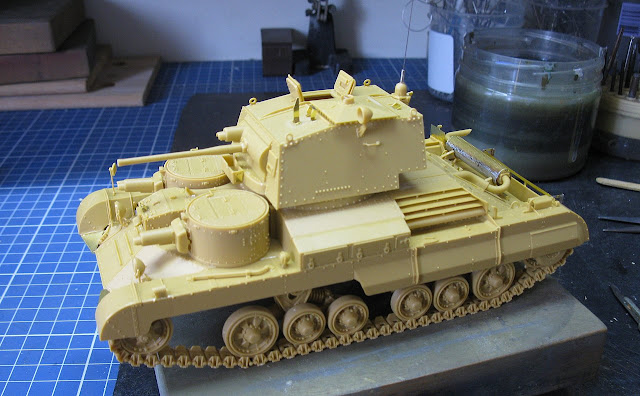 |
| Adding the final details to the model. This kit is very nice to build... |
 |
| Ready for painting... |
I will follow the manufacturer's painting suggestion, as my client opted for the Caunter Scheme and the historical references provided by the decal sheet are correct Very well done, Bronco!!!). I redid the colored profile art following the Panzerserra Bunker pattern. Meet ANTELOPE, a Cruiser Mk.I A9 tank belonging to 7th Armoured Division, 1st Royal Tank Regiment, A Squadron, who fought at Derna Pass, Libya, in April, 1941.
I'll be using a Caunter Scheme paint kit from AK Real Colors: Portland Stone, Silver Grey and Slate. First of all, let's paint the kit with the color Portland Stone, following the pattern above:
 |
| Portland Stone in the indicated areas... |
 |
| Portland Stone color: left view |
 |
| Portland Stone color: right view |
Now, let's isolate the areas in Portland Stone so we can apply the Silver Grey color. In this type of camouflage, I always apply the colors from light to dark...
 |
| Using masking tape to isolate areas in Portland Stone. left view |
 |
| Using masking tape to isolate areas in Portland Stone. right view |
 |
| Applying the Silver Grey color left view |
 |
| Applying the Silver Grey color right view |
And finally, masking the Silver Grey with masking tape to apply the Slate color.
 |
| Applying the Slate color left view |
 |
| Applying the Slate color right view |
Now all we need to do is remove the masking tape and see the interesting optical effect that only Caunter Scheme camouflage can provide...
 |
| Caunter Scheme camouflage right view |
 |
| Caunter Scheme camouflage front left view |
 |
| Caunter Scheme camouflage left view |
 |
| Caunter Scheme camouflage rear left view |
 |
| Caunter Scheme camouflage top view |
I airbrushed thin coats of clear gloss varnish to the desired areas of the markings to avoid the infamous silvering on the decals. After the varnish is completely dry, decals!!!
 |
| Decals in position - front left view |
 |
| Decals in position - front right view These British markings are simply beautiful!!! |
 |
| Decals in position - rear right view... ANTELOPE was born!!! |
 |
| Water cans with decals... |
 |
| Water cans with decals... |
 |
| Tires, tracks and exhaust mufler... Starting the weathering... |
 |
| Front left view |
 |
| Right view |
 |
| Water cans in position... |
I'm going to use a small detail from Value Gear to highlight the model... but it's important that the roll bag doesn't interfere with the rotation of the tower... You never know where the danger might come from...
 |
| Roll Bag from Value Gear... Turning the turret to 7 o'clock... free!! |
 |
| Enemy at 11 o'clock!!! |
 |
| I carved a groove in the ventral portion of the resin roll bags to fit the hinges on the tank's toolbox... |
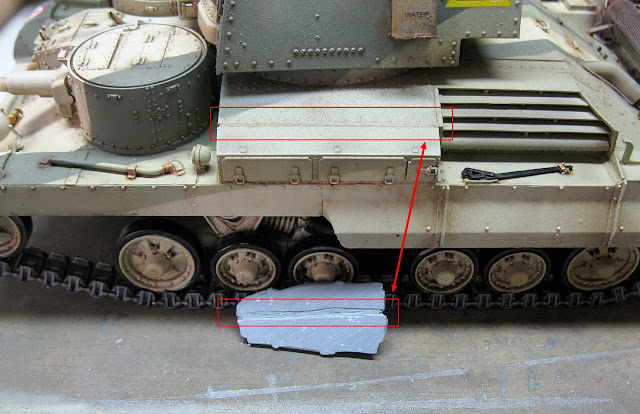 |
| Kojak is a detail-oriented guy... Everything to avoid interfering with the turret's derivation... |
 |
| And the roll bags after being painted and installed on the toolbox... |
 |
| Derivation at 11 o'clock... Notice the water can in the turret's side |
 |
| and to 7 o'clock. Perfect!! |
And no English vehicle in the desert would be complete without its signal flags on the radio antenna: tracing paper painted (on both sides) in the desired colors... Detail: before painting, I folded the paper and made a clear crease, so that we could then cut the pennants more easily and correctly, without the risk of "scratching" the paint when folding the pennants...
 |
| The creased and painted tracing paper... Now, just wait for it to dry. |
 |
| Once dry, we fold the paper at the crease and cut the paper into the desired shape... Then, just glue the pennants with PVA glue, including the antenna in the crease of the pennant... Easy! |
 |
| Applying washes and desert sand color pigments... left view |
 |
| Right view. |
And after more weathering with chipping and other small details, I call this girl finished. Introducing ANTELOPE: a Cruiser Mk.I A9 British tank, belonging to 7th Armoured Division, 1st Royal Tank Regiment, A Squadron, being seen shortly before her tragic fate at Derna Pass, Libya, in April, 1941.
 |
| Cruiser Mk.I A9 British tank ANTELOPE 7th Armoured Division - 1st Royal Tank Regiment - A Squadron Derna Pass, Libya - April, 1941. |
 |
| Cruiser Mk.I A9 British tank ANTELOPE front right view |
 |
| Cruiser Mk.I A9 British tank ANTELOPE right view |
 |
| Cruiser Mk.I A9 British tank ANTELOPE rear right view |
 |
| Cruiser Mk.I A9 British tank ANTELOPE rear view |
 |
| Cruiser Mk.I A9 British tank ANTELOPE rear left view |
 |
| Cruiser Mk.I A9 British tank ANTELOPE top rear left view |
 |
| Cruiser Mk.I A9 British tank ANTELOPE left view |
 |
| Cruiser Mk.I A9 British tank ANTELOPE front left view |
 |
| Cruiser Mk.I A9 British tank ANTELOPE front left view |
 |
| Cruiser Mk.I A9 British tank ANTELOPE front view |
 |
| Cruiser Mk.I A9 British tank ANTELOPE top left view |
 |
| Cruiser Mk.I A9 British tank ANTELOPE with Kojak!! |
 |
| Two desert girls: Cruiser Mk.I A9 British tank ANTELOPE and Panzer III Ausf G - Sd.Kfz. 141, side by side. |
 |
| Cruiser Mk.I A9 British tank ANTELOPE 7th Armoured Division - 1st Royal Tank Regiment - A Squadron Derna Pass, Libya - April, 1941. |
Thank you for being with us, once again!!!
Stay tuned here!!!
More things will come soon!!!








%20medium%20tanks%20from%20the%207th%20Armoured%20Division,%20British%20Army%20Western%20Desert%20Force%20drive%20through%20the%20city%20streets%20of%20Cairo%20circa%20February%201940%20in%20Cairo,%20Egypt.%20big.jpg)




Marcos, Outra beldade meu amigo!! (Another beauty my friend!!)
ResponderExcluirHi, Rick...Thanks for the incentive, my friend!!! Um grande abraço!!!
ExcluirHello my friend, I wanted to ask what's going on, why you haven't been in touch? We are still waiting for photos from the construction of your beautiful models... Best regards, Roman K. from Prague
ResponderExcluirHi, BatX21 ... Sorry for the disappearance, but I underwent emergency heart surgery and was in the garage, but now, everything is fine. Injection system redone, with great results. The old chassis is ready for new missions... Soon, we will have updates on the Bunker. Hugs!!
ExcluirI'm so sorry, I wish you a speedy full recovery, take care, best regards, Roman from Prague
ExcluirThanks again, BatX21!!
ExcluirEspero que todo vaya bien, se echan de menos sus trabajos. Un saludo
ResponderExcluirHolla, Carlos... Gracias por perguntar...Perdón por desaparecer, pero me operaron de urgencia del corazón y estaba en el garaje, pero ahora todo está bien. Sistema de inyección reconstruido, con muy buenos resultados. El viejo chasis está listo para nuevas misiones... Pronto tendremos actualizaciones en el Bunker. Saludos!!!
Excluir